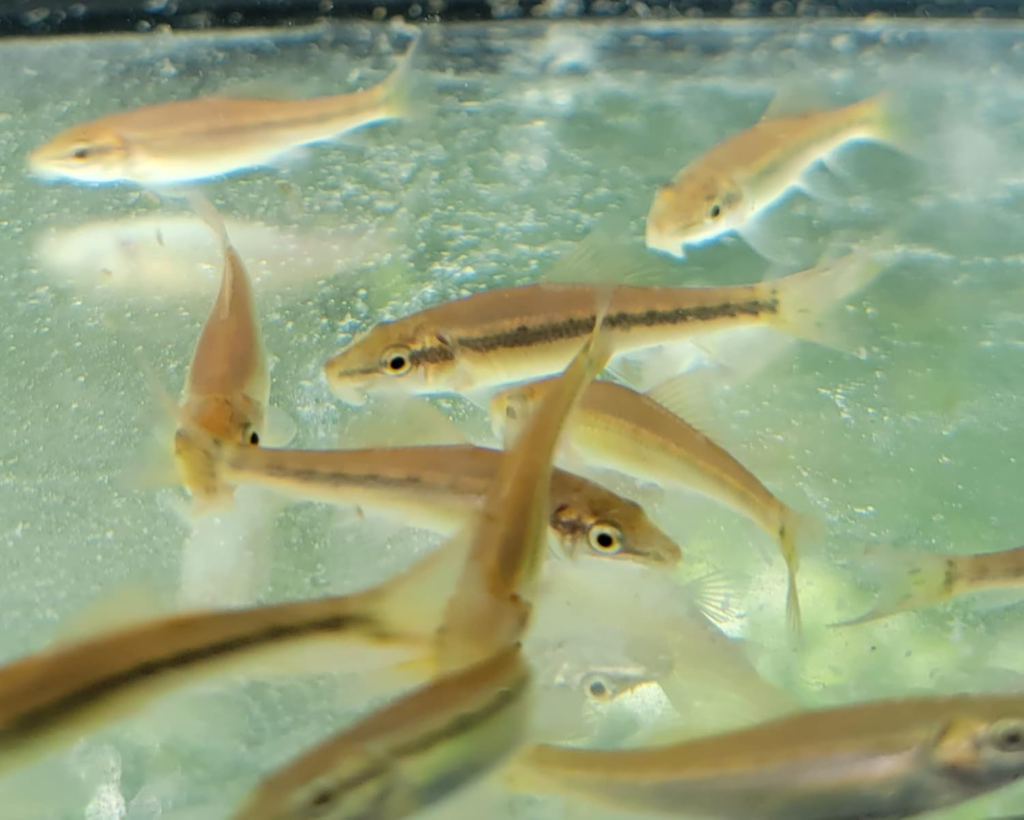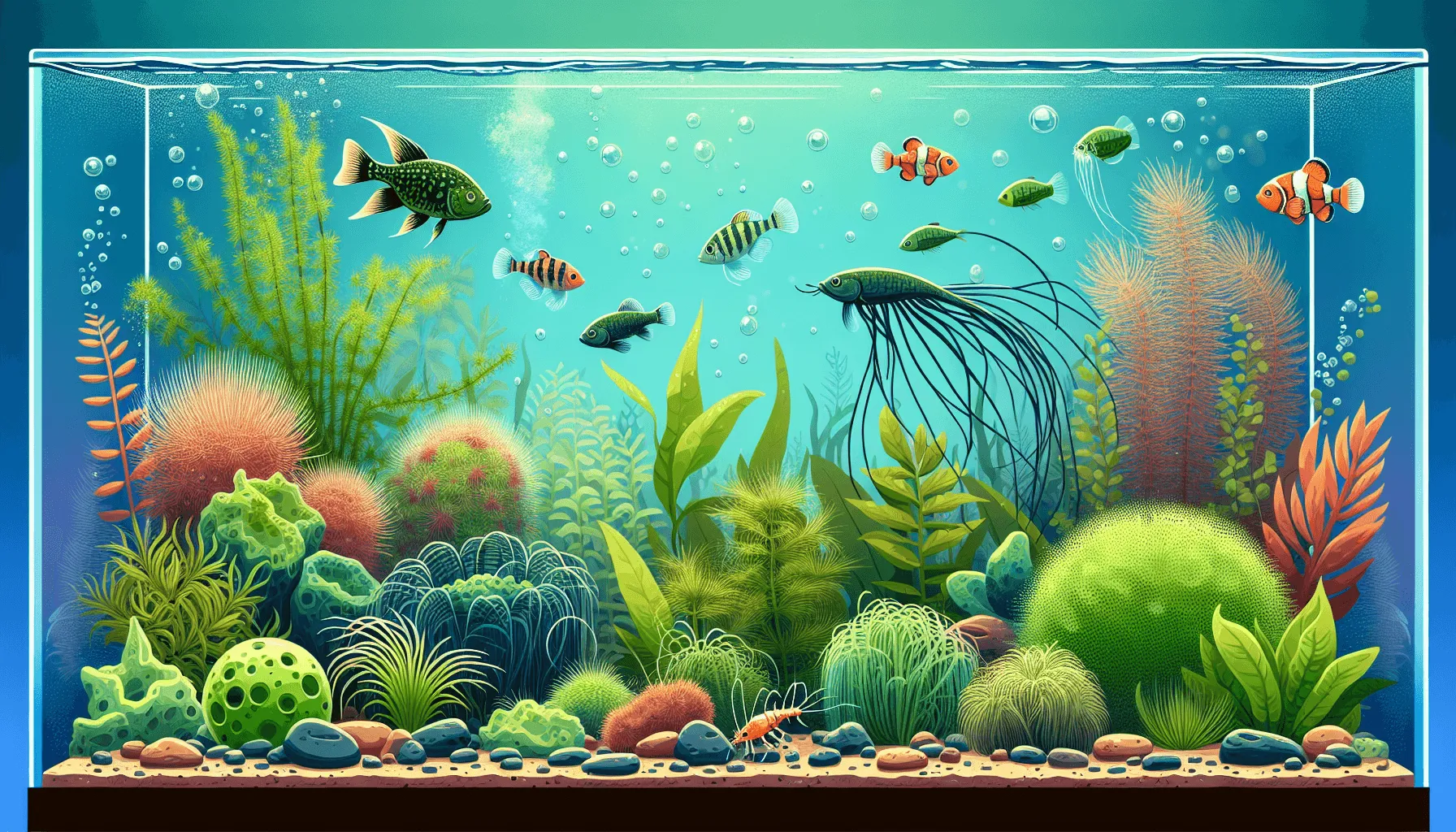Are you struggling with persistent algae growth in your aquarium? Algae eating fish offer a natural, efficient solution to maintain clear water while adding life to your tank. These specialized aquatic cleaners work tirelessly to consume various types of algae, creating a balanced ecosystem in your aquarium.
Algae eater fish serve multiple purposes in your tank:
- Natural algae control without chemicals
- Improved water quality through biological filtration
- Enhanced oxygen levels through their constant movement
- Added visual interest with unique behaviors and appearances
Your choice of algae eater can significantly impact your aquarium’s health. From the hardy Bristlenose Plecostomus to the industrious Amano Shrimp, each species brings its own set of benefits and requirements.
Ready to discover the perfect algae-eating companion for your aquarium? We’ll guide you through the top 10 best algae eater fish, helping you make an informed decision based on your tank size, existing community, and specific algae challenges.
Understanding Algae and Its Types
Algae growth in aquariums presents both challenges and benefits for your underwater ecosystem. You’ll encounter several distinct types of algae, each requiring specific approaches for effective control.
Common Types of Algae in Aquariums:
- Green Spot Algae (GSA): Appears as small, circular green spots on aquarium glass and plant leaves
- Black Beard Algae (BBA): Dark, brush-like growths that attach to hardscape and plant edges
- Hair Algae: Long, green strands that float or attach to surfaces
- Brown Algae (Diatoms): Brownish coating commonly found in new tank setups
- Blue-Green Algae: Actually a form of bacteria that creates a slimy, sheet-like covering
These algae varieties affect your aquarium’s water quality in different ways:
- Nutrient Competition: Algae compete with plants for essential nutrients
- Oxygen Depletion: Excessive algae growth can reduce oxygen levels
- pH Fluctuations: Some species cause significant pH swings
- Visual Impact: Dense algae growth blocks light from reaching aquatic plants
While small amounts of algae are natural, problematic species like hair algae and green spot algae can quickly overtake your tank. These aggressive varieties often require targeted control methods, including specialized algae-eating fish that have evolved to consume specific types of algae.
The key to successful algae management lies in identifying the specific variety present in your tank and selecting appropriate algae eaters that target these growth patterns.
Criteria for Choosing Algae Eater Fish
Selecting the right algae eater for your aquarium requires careful consideration of several key factors to ensure both the fish’s well-being and your tank’s ecosystem balance.
1. Tank Size Requirements
Different species of algae eaters have varying space needs. It’s crucial to select a fish that can thrive in your tank size.
- Small tanks (under 40 liters): Choose compact species like Otocinclus Catfish or Nerite Snails
- Medium tanks (40-120 liters): Consider Bristlenose Plecos or Siamese Algae Eaters
- Large tanks (120+ liters): Suitable for Chinese Algae Eaters and other larger species
2. Water Parameters
Algae eaters, like all fish, have specific water conditions they prefer. Ensure that the species you choose can comfortably live in your tank’s water parameters.
- Temperature range compatibility
- pH level preferences
- Water hardness requirements
3. Community Tank Compatibility
If you have other fish in your aquarium, it’s essential to consider how the new algae eater will fit into the existing community.
- Peaceful vs. territorial behavior
- Size comparison with existing fish
- Swimming level preferences (bottom, middle, or top-dwelling)
10 Proven Tips to Catch Koi Fish in Your Pond Effectively
4. Dietary Needs
While algae eaters primarily consume algae, some species may have additional dietary requirements. Understanding these needs will help you provide a balanced diet.
- Primary algae type they consume
- Supplementary feeding requirements
- Competition for food with other tank inhabitants
5. Maintenance Level
Certain algae eaters may have specific habitat preferences that require extra care in terms of tank maintenance.
- Space requirements for hiding spots
- Specific substrate preferences
- Water flow needs
- Regular water change frequency
6. Growth Rate and Adult Size
It’s important to consider how big the algae eater will get and how quickly it will grow. This information will help you plan for its space needs as it matures.
- Maximum size potential
- Growth speed
- Space requirements at full maturity
Remember to research each species’ specific care requirements and behavioral patterns. A fish that seems perfect for algae control might not suit your tank’s current setup or community dynamics.
10 Best Algae Eater Fish for Your Aquarium
Here are the most effective algae-eating fish species you can add to your aquarium. These aquatic cleaners work tirelessly to maintain crystal-clear water and healthy tank conditions.
1. Algae Eater Fish Aquarium : Bristlenose Plecostomus

The Bristlenose Pleco is one of the best algae eaters out there. These unique catfish, scientifically known as Ancistrus cirrhosus, have a special body shape and bristles on their noses – which is why they’re called that.
Key Features:
- Size: 4-5 inches
- Lifespan: 5-10 years
- Tank Size: Minimum 120 liters
- Temperature Range: 60-80°F
Habitat Requirements:
- Well-oxygenated water
- pH levels between 6.5-7.5
- Plenty of hiding spots
- Driftwood pieces for grazing
These hardworking fish are great at eating green spot algae and diatoms, which are types of algae that can be tough to get rid of. Their special mouth shape lets them stick to different surfaces, making them really good at cleaning things like aquarium glass and rocks.
Feeding Behavior:
- Primary diet consists of soft algae
- Excellent at consuming biofilm
- Grazes continuously throughout the day
- Requires supplemental food when algae is scarce
The Bristlenose Pleco is friendly and gets along well with other fish, so it’s perfect for community tanks. Unlike their bigger relatives, the Common Pleco, these fish stay relatively small and won’t outgrow most home aquariums. They’re especially active in the evenings when they go around cleaning up any unwanted algae.
Tank Maintenance Benefits:
- Reduces manual glass cleaning
- Helps prevent algae buildup
- Improves water clarity
- Creates natural tank aesthetics
2. Siamese Algae Eater (SAE)
Siamese Algae Eaters are known as top-notch cleaners in the aquarium world, growing up to 6 inches long when fully grown. These fish are dedicated algae hunters with a hearty appetite for various types of algae:
- Hair algae
- Black beard algae
- Brown algae
- Green thread algae
Your SAE needs a spacious environment to thrive – a minimum tank size of 120 liters provides enough swimming space and territory. These fish are active and love to swim around the tank, exploring different levels in search of their next meal.
Tank Setup Requirements:
- Temperature: 75-79°F
- pH: 6.5-7.0
- Water hardness: 5-15 dGH
- Strong water flow
- Well-oxygenated water
SAEs work best in groups of 3-5 specimens, creating a more natural and effective algae-control system. They’re peaceful community fish, though they might display mild territorial behavior toward similar-looking species. You’ll recognize them by their distinctive black stripe that runs from nose to tail, which sets them apart from other similar species.
3. Algae Eater Fish Aquarium : Otocinclus Catfish
Otocinclus Catfish are like tiny cleaning crews for your aquarium, measuring only 1-2 inches long. These little powerhouses are great at keeping the tank clean by munching on soft green algae.
Ideal Tank Conditions for Otocinclus Catfish
Your Otocinclus will do well in tanks as small as 35 liters, which makes them a perfect fit for nano aquariums. Here are the specific conditions they need:
- Water temperature: 72-79°F
- pH levels: 6.0-7.5
- Gentle water flow
- Well-planted environment with driftwood
Social Behavior and Tank Mates
These peaceful catfish are very social creatures, so it’s best to keep them in groups of 6 or more. They get along well with other fish species such as:
- Tetras
- Rasboras
- Dwarf Corydoras
- Small peaceful fish
Benefits of Otocinclus Catfish
Unlike larger algae eaters, Otocinclus Catfish won’t outgrow your tank or become territorial. Their gentle nature and small size allow them to reach tight spaces between plants and decorations where algae tends to build up.
Diet and Feeding
To ensure their health and activity, you’ll need to provide additional food sources like algae wafers and blanched vegetables during times when there isn’t much algae growth in the tank.
4. Chinese Algae Eater Fish

Chinese Algae Eaters Fish are highly effective in combating stubborn algae growth in your aquarium. These fish start off small but have the potential to grow up to 11 inches long, so they need a spacious tank that holds at least 250 liters of water.
Cleaning Abilities of Young Chinese Algae Eaters
Young Chinese Algae Eaters Fish are known for their impressive cleaning abilities, specifically targeting:
- Filamentous algae
- Brush algae
- Soft green algae
- Diatoms
Tank Setup Requirements for Chinese Algae Eaters Fish
To create a suitable environment for these fish, make sure to meet the following tank setup requirements:
- Maintain a temperature range of 74-80°F
- Keep the pH level between 6.0 and 8.0
- Ensure water hardness is between 5 and 15 dGH
- Provide strong water flow in the tank
- Include plenty of hiding spots using rocks and driftwood
Important Note About Adult Chinese Algae Eaters Fish
It’s important to note that as Chinese Algae Eaters mature, their behavior undergoes a significant change. Adult Chinese Algae Eaters often become territorial and may harass other tank inhabitants, especially slow-moving or bottom-dwelling species. Additionally, their diet shifts from primarily algae to a more protein-rich menu.
Tips to Minimize Aggressive Behavior
To minimize aggressive behavior in adult Chinese Algae Eaters Fish, consider implementing the following strategies:
- Provide ample space in the tank
- Include multiple hiding spots using rocks and driftwood
- Keep only one Chinese Algae Eater per tank
- Add them to tanks with fast-swimming fish
5. Reticulated Hillstream Loach
The Reticulated Hillstream Loach, a fascinating algae eater, boasts a unique body structure designed for life in fast-moving waters. These specialized fish have a flattened belly that acts like a suction cup, allowing them to grip onto surfaces while feeding on stubborn algae deposits.
What They Clean
You’ll find these distinctive cleaners excelling at removing algae from:
- Flat rocks and stones
- Tank glass surfaces
- Driftwood
- Smooth decorative elements
Their Habitat Requirements
The Reticulated Hillstream Loach has specific habitat needs to thrive:
- Water temperature: 68-75°F
- Tank size: minimum 70 liters
- High oxygen levels
- Strong water movement
Their specialized mouth structure enables them to scrape off tough algae that other fish might struggle with. This makes them particularly valuable for tanks with persistent algae problems on flat surfaces.
Social Creatures
These peaceful fish work best in groups of 3-4, creating an efficient cleaning crew that methodically covers your aquarium’s surfaces. Their attractive patterns and unique appearance add visual interest while they perform their valuable maintenance duties. Interestingly, there are some fascinating facts about the Hillstream Loach that further highlight their unique characteristics and behaviors.
6. Nerite Snails : Algae Eater Fish for Aquarium
Nerite Snails are the best glass cleaners for your aquarium. These small but powerful creatures work hard to scrape algae off aquarium surfaces, leaving your tank sparkling clean.
Key Benefits:
- Natural glass cleaners that reach tight corners
- Attractive shell patterns add visual interest
- Safe for planted tanks
- Won’t reproduce in freshwater
Your Nerite Snails will thrive with these care requirements:
- Water temperature: 72-78°F
- pH level: 7.0-8.5
- Tank size: 5+ gallons
- Diet: Supplement with algae wafers when natural algae is scarce
These decorative snails come in various patterns, including zebra, tiger, and spotted varieties. You’ll appreciate their peaceful nature as they methodically clean your tank without disturbing other inhabitants. Their small size allows them to access areas larger algae eaters can’t reach, making them perfect for nano tanks and detailed aquascapes.
A group of 1-2 Nerite Snails per 5 gallons provides optimal cleaning power without overcrowding. These hardy cleaners adapt well to most aquarium conditions, requiring minimal maintenance beyond basic water care.
7. Amano Shrimp
Amano Shrimp are known as excellent cleaners in the aquarium world. These transparent crustaceans, reaching about 2 inches in length, can eat various types of algae:
- Black beard algae
- Hair algae
- Green spot algae
- Soft film algae
- Diatoms
Their constant feeding habits improve the water quality in your tank as they systematically graze on algae-covered surfaces. These hardworking cleaners are great at getting into tight spaces between plants and decorations where other algae-eating fish can’t reach.
Choosing Tankmates for Amano Shrimp
When adding Amano Shrimp to your aquarium, it’s important to consider their size compared to other inhabitants. While they are generally peaceful, these shrimp need tankmates that won’t see them as food. Fish smaller than 2 inches make ideal companions, such as:
- Neon Tetras
- Guppies
- Rasboras
- Small Corydoras
Optimal Group Size for Amano Shrimp
A group of 3-5 Amano Shrimp per 10 gallons provides the best cleaning coverage while ensuring they feel safe in their environment. Their transparent bodies offer natural protection from predators, allowing them to focus on their algae-eating tasks.
8. Florida Flagfish : Algae Eater Fish for Aquarium
The Florida Flagfish stands out in the aquarium world with its striking appearance – vibrant red stripes against a metallic blue-green body create a distinctive American flag pattern. These eye-catching fish reach about 2.5 inches in length, making them perfect for medium-sized tanks.
What sets Florida Flagfish apart is their specialized appetite for blue-green algae, a problematic type that many other algae eaters avoid. You’ll find these determined cleaners actively patrolling your tank, consuming not just blue-green algae but also hair algae and other soft varieties.
These peaceful community fish thrive in groups of 4-6 specimens. Your Florida Flagfish will coexist harmoniously with:
- Tetras
- Rasboras
- Peaceful bottom dwellers
- Small catfish species
Tank Requirements:
- Temperature: 64-75°F
- pH: 6.5-7.5
- Tank size: 20 gallons minimum
- Plants: Live plants for grazing and shelter
Florida Flagfish adapt well to both tropical and subtropical conditions, displaying their best colors in slightly cooler water. Males develop brighter patterns during breeding season, adding an extra splash of color to your aquarium while maintaining its cleanliness.
9. Molly Fish : Algae Eater Fish for Pond
Molly Fish are versatile algae eaters that bring both functionality and beauty to your aquarium. These active swimmers target filamentous algae, including hair and staghorn varieties, making them effective tank cleaners.
Key Characteristics:
- Size: 3-4 inches
- Tank Size: 20+ gallons
- Temperature: 72-78°F
- pH: 7.5-8.5
As livebearers, Molly Fish have a unique advantage – they reproduce readily in captivity. Males display vibrant courtship behaviors, adding dynamic movement to your tank without disrupting other fish. Their breeding habits create a self-sustaining population, ensuring continuous algae control.
Care Requirements:
- Hard, alkaline water conditions
- Plant coverage for fry survival
- Regular water changes
- Supplemental feeding with vegetable matter
These hardy fish adapt well to community tanks, peacefully coexisting with similar-sized species. Their constant grazing behavior helps maintain clear tank walls and decorations. You’ll notice them particularly active during daylight hours, systematically working through algae-covered surfaces.
The black molly variant proves especially effective at algae control, while sailfin varieties add dramatic flair to your aquarium’s appearance. Their combination of algae-eating efficiency and easy care requirements makes them an excellent choice for both beginners and experienced aquarists.
However, it’s important to monitor their health closely as they can be susceptible to certain diseases if not properly cared for. In such cases, you may need to seek advice from forums like Think Fish, where experienced aquarists share valuable insights on dealing with fish health issues.
10. Rosy Barb : Algae Eater Fish for Tank
Rosy Barbs are not only beautiful fish that add color to your aquarium, but they also help keep it clean by eating algae. These peaceful fish grow to about 3 inches long and have bright reddish-orange colors, making them great additions to community tanks.
Natural Algae Controllers
Rosy Barbs are particularly attracted to hair algae and staghorn varieties. They have a natural instinct to graze on algae, which helps keep the surfaces of your tank clean. Throughout the day, these fish will methodically pick at the algae, ensuring that it doesn’t take over your aquarium.
Social Swimmers
These fish thrive in groups of 6 or more. When kept in schools, Rosy Barbs create an engaging display of movement as they swim together and search for food. This social behavior not only adds visual interest to your tank but also promotes their overall well-being.
Key Characteristics
- Unheated tank compatibility
- School-oriented behavior
- Gentle temperament suitable for community setups
- Active algae consumption patterns
To provide the best environment for your Rosy Barbs, here are some tips:
- Create a well-planted tank with plenty of hiding spots and open swimming areas.
- Ensure stable water conditions by regularly monitoring parameters such as temperature and pH.
- Offer a varied diet that includes high-quality flakes or pellets along with occasional treats like freeze-dried or live foods.
By following these guidelines, you’ll create a thriving habitat where your Rosy Barbs can flourish while effectively controlling algae growth in your aquarium.
Maintaining a Healthy Aquarium with Algae Eaters
A successful aquarium ecosystem depends on proper balance and maintenance. Adding algae eaters requires careful planning and monitoring to ensure their effectiveness and survival.
Key Maintenance Practices:
- Test water parameters weekly using reliable test kits
- Monitor ammonia, nitrite, and nitrate levels
- Maintain consistent pH levels suitable for all species
- Keep water temperature stable within acceptable ranges
Creating a Balanced Ecosystem
Different algae eaters target specific types of algae. You can combine multiple species to achieve comprehensive algae control:
- Bottom dwellers (like Bristlenose Plecos) for substrate cleaning
- Mid-water swimmers (such as Siamese Algae Eaters) for plant surfaces
- Surface cleaners (including snails) for glass and decorations
The Nitrogen Cycle
Your aquarium must complete the nitrogen cycle before introducing algae eaters. This process establishes beneficial bacteria that:
- Convert toxic ammonia to nitrites
- Transform nitrites into less harmful nitrates
- Create a stable environment for all inhabitants
Feeding Guidelines
Even dedicated algae eaters need supplemental nutrition:
- Provide algae wafers during periods of low algae growth
- Include vegetable-based foods in their diet
- Feed small portions to prevent overfeeding and water pollution
Remember to maintain proper stocking levels – overcrowding can lead to increased waste and stress on your aquarium’s biological filtration system.
Conclusion
Choosing the right algae eating fish transforms your aquarium maintenance routine from a chore into a natural, self-sustaining process. Each species brings unique benefits and behaviors to your tank ecosystem. Take time to research their specific needs, temperaments, and compatibility with your existing aquatic community.
Your success with algae eating fish depends on:
- Matching fish to your tank size
- Understanding their dietary requirements
- Creating appropriate hiding spots
- Maintaining stable water parameters
- Ensuring compatibility with tank mates
Remember: these fascinating creatures aren’t just cleaners – they’re living beings that need proper care and attention. Make your selection based on both their algae-eating efficiency and your ability to meet their care requirements. Your thoughtful choice will reward you with a cleaner, healthier, and more vibrant aquarium environment.
FAQs (Frequently Asked Questions)
What are algae eater fish and why are they important for aquariums?
Algae eater fish are species that consume algae, helping to maintain a healthy aquarium ecosystem. They play a crucial role in controlling algal growth, which can affect water quality and the overall health of the tank.
What types of algae are commonly found in aquariums?
Common types of algae found in aquariums include hair algae, green spot algae, and diatom algae. Each type can have different effects on water quality and may require specific algae eater fish for control.
How do I choose the right algae eater fish for my aquarium?
When selecting algae eater fish, consider factors such as tank size, compatibility with other fish species, and the specific needs of each species. Understanding these criteria ensures a harmonious environment in your aquarium.
What is the habitat requirement for Bristlenose Plecostomus?
Bristlenose Plecostomus thrive in freshwater environments with plenty of hiding spots and a well-maintained tank. They are effective at consuming green spot and diatom algae, making them an excellent choice for keeping tanks clean.
Are Nerite Snails good for controlling algae in aquariums?
Yes, Nerite Snails are effective glass cleaners and contribute to maintaining water quality by consuming various types of algae. They also add an attractive element to aquarium decor.
What types of algae do Amano Shrimp consume?
Amano Shrimp are known to consume several types of algae, including black beard algae. They are valuable contributors to maintaining water quality and can coexist with various fish species when size considerations are taken into account.




